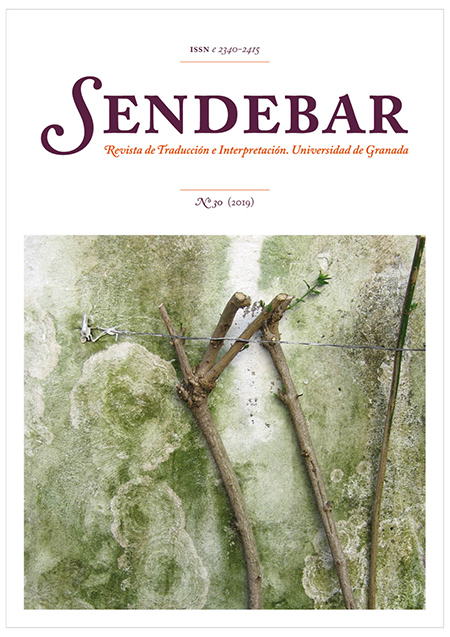Validación en base a Modelo Rasch, como criterio para la valoración del rendimiento de la interpretación consecutiva
DOI:
https://doi.org/10.30827/sendebar.v30i0.8512Palabras clave:
interpretación consecutiva, matriz de evaluación, rendimiento de interpretación, validaciónResumen
La presente investigación tiene por objeto elaborar y validar un criterio de evaluación del rendimiento de la interpretación consecutiva. Al principio, los investigadores mantuvieron una entrevista con los expertos y profesores de interpretación a fin de conocer los ítems involucrados en la evaluación de la traducción oral consecutiva, y luego, crearon una lista de verificación bajo el título de valoración de interpretación, comprendida por 38 ítems de temas comunes recogidos en las entrevistas realizadas, y se descubrió que unos 25 ítems fueron compatibles con el modelo Rasch. Entonces, los investigadores redactaron 25 ítems en 4 niveles tomando como base la escala Likert, y aplicaron este criterio para la evaluación de la interpretación consecutiva de 105 estudiantes homogeneizados desde el punto de vista de conocimiento lingüístico, y como consecuencia, se reveló que este criterio cuenta con 7 factores con un valor superior a 1 y su contenido abarca un 77% de la variación. En la fase final del ensayo, los resultados del Modelo de Ecuaciones Estructurales (SEM, por sus siglas en inglés) demostraron la buena compatibilidad de los datos. El criterio de evaluación final comprendía 4 factores y 22 ítems. El presente estudio también presenta estrategias prácticas para los estudiantes y profesores de traducción oral.
Descargas
Citas
Angelelli, C. (2009). Using a Rubric to Assess Translation
Ability: Defining the Construct. In C. Angelelli, & H. Jacobson, Testing and assessment in translation and interpreting studies (pp. 13-48). John Benjamins Publication Co.: Amsterdam.
Bachman, L. F. (2014). Ongoing Challenges in Language Assessment. In A. J. Kunnan (Ed.), The companion to language assessment (Vol. 3), (pp. 1586-1603). Oxford: John Wiley and Sons.
Bachman, L. F., & Palmer, A. S. (1996). Language Testing in Practice: Designing and Developing Useful Language Tests (Vol. 1). New York: Oxford University Press.
Beeby, A. (2000). Teaching Translation from Spanish to English. Ottawa: University of Ottawa Press.
Bond, T. G. & Fox, C. M. (2007). Applying the Rasch Model: Fundamental Measurement in the Human Sciences. Mahwah, NJ.: Lawrence Erlbaum.
Brookhart, S. M. (2011). Educational Assessment Knowledge and Skills for Teachers. Educational Measurement: Issues and Practice, 30 (1), 3-12.
Campbell, S., & Hale, S. (2003). Translation and Interpreting Assessment in the Context of Educational Measurement. Translation Today: Trends and Perspectives 14, 205-224.
Care, E. & Griffin, P. (2009). Assessment is for Teaching. Independence 34 (2), 56-59.
Clifford, A. (2001). Discourse Theory and Performance-based Assessment: Two Tools for Professional Interpreting. Meta 46 (2), 365–378.
Clifford, A. (2005). A Preliminary Investigation into Discursive Models of Interpreting as a Means of Enhancing Construct Validity in Interpreter Certification. Doctoral dissertation, University of Ottawa. Ottawa, Canada.
Cohen, A. D. (1994). Assessing Language Ability in the Classroom. Boston: Heinle & Heinle Publishers.
Conde, T. (2011). Translation Evaluation on the Surface of Texts: A Preliminary Analysis. The Journal of Specialized Translation 69 (15), 69-86.
Dornyei, Z. (2007). The Psychology of the Language Learner Individual Differences in Second Language Acquisition. Mahwah, NJ: Lawrence Erlbaum Associates.
Earl, L. M. (2013). Assessment as Learning: Using Classroom Assessment to Maximize Student Learning (2nd ed.). Thousand Oaks, California: Corwin.
Griffin, P., & Nix, P. (1991). Educational Assessment and Reporting. Sidney: Harcout Brace Javanovich Publisher.
Hatim, B., & Mason, I. (1997). The Translator as Communicator. London & New York: Routledge.
House, J. (1997). Translation Quality Assessment: A Model Revisited. Nehren: Gunter NarrVerlag Tubingen.
House, J. (2001). Translation Quality Assessment: Linguistic Description versus Social Evaluation. Translators' Journal 46 (2), 243-257.
Lamprianou, I. & Athanasou, J. A. (2009). A Teacher’s Guide to Educational Assessment (Revised edition). Rotterdam: Sense.
Lantolf, J. P., & Poehner, M. E. (2004). Dynamic Assessment: Bringing the Past into the Future. Journal of Applied Linguistics 1(1), 49-74.
LeCompete, M. & Preissle, J. (1993). Ethnography and Qualitative Design in Education Research. San Diego, CA: Academic Press.
Linacre, J. M. (2009). Winsteps (Version 3.68) [Computer Software]. Beaverton, Oregon: Winsteps.com.
McMillan, J. H. (2014). Classroom Assessment: Principles and Practice for Effective Standards based Instruction (6th ed.). Boston: Pearson Education.
Mertler, C. A. (2001). Designing Scoring Rubrics for your Classroom. Practical Assessment, Research & Evaluation 7 (25), 1-10.
Moss, A., & Holder, C. (1988). Improving Student Writing. Dubuque, IO: Kendall/ Hunt.
Newmark, P. (1988). A Textbook of Translation. New York: Prentice-Hall International.
Popham, W. J. (2014). Classroom Assessment: What Teachers Need to Know. Boston: Pearson Education.
Rea-Dickins, P. (2008). Classroom-based language assessment. In E. Shohamy & N. H. Hornberger (Eds.) Encyclopedia of Language and Education: Language Testing and Assessment (pp. 257–271). New York, NY: Springer.
Sawyer, D. B. (2004). Fundamental Aspects of Interpreter Education: Curriculum and Assessment. Amsterdam & Philadelphia: John Benjamins.
Scriven, M. (2007). Key Evaluation Checklist. Retrieved March 2016 from:
http://www.wmich.edu/evalctr/archive_checklists/kec_feb07.pdf
Stobart, G., & Gipps, C. (1997). Assessment: A Teacher's Guide to the Issues (3rd ed.). London: Hodder & Stoughton.
Tabachnick, B. G., & Fidell, L. S. (2001). Using Multivariate Statistics (4th ed.). New York: HarperCollins.
Tannen, D. (2007). Talking Voices: Repetition, Dialogue, and Imagery in Conversational Discourse (Vol. 26). London: Cambridge University Press.
Waddington, C. (2001). Should Translations be Assessed Holistically or through Error Analysis? Hermes, Journal of Linguistics, 26. Retrieved August 2016 from http://download2.hermes.asb.dk/archive/download/H2603.PDF
Walvood, B. E., & Anderson, V. J. (1998). Effective Grading. San Francisco: Jossey-Bass.
Wiggins, G. (1998). Educative Assessment: Designing Assessments to Inform and Improve Student Performance. London: Jossey-Bass Publishers.
Wiliam, D. (2010). An Integrative Summary of the Research Literature and Implications for a New Theory of Formative Assessment. In H. L. Andrade & G. J. Cizek (Eds.), Handbook of formative assessment (pp. 18-40). New York: Routledge.
Wilss, W. (1998). Decision Making in Translation. In M. Baker (Ed.), Routledge encyclopedia of translation studies (pp. 57-60). London/New York: Rutledge.
Descargas
Publicado
Cómo citar
Número
Sección
Licencia
Terminos de Licencia Sendebar.

















